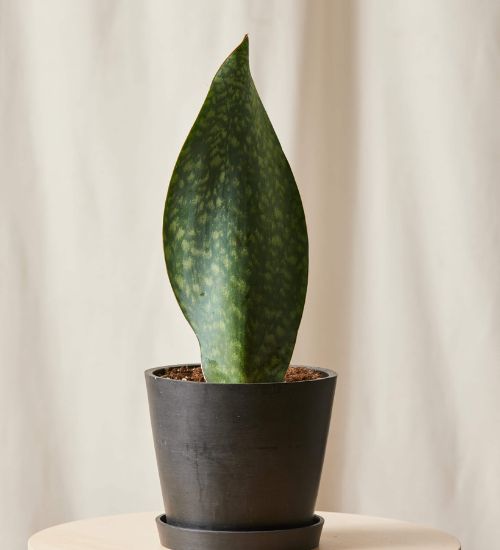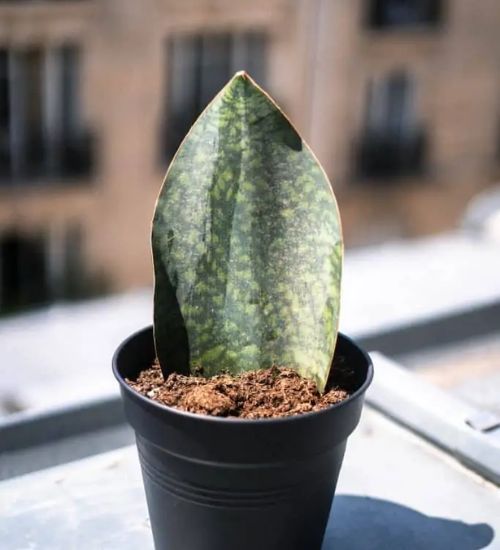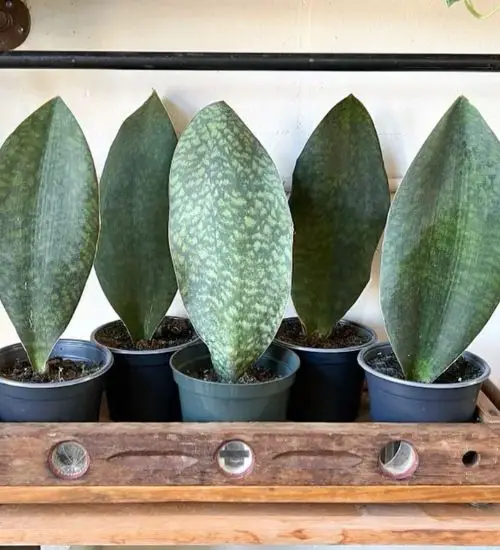Sun: Partial sun to partial shade
Water: Typical water needs for a succulent
Temperature: Zone 10a from 30° F to 35° F (-1.1 ° C to 1.7° C) to Zone 11b from 45° F to 50° F (7.2° C to 10° C)
Winter Survival: Not cold hardy
Propagation: leaves
Flower: In the Spring
Flower Type: Green, white
Toxic: Toxic to humans and animals
Dormant: winter
Space Requirement: Indoors & Outdoors
Common Problems: Plants may rot if overwatered, pests
Where to buy Sansevieria ‘Whale Fin’?
Basc Care for Sansevieria ‘Whale Fin’
Watering
What you need to remember is that this type of succulents needs to be watered for every 2 weeks
One simple tip for you is that you can use some online apps to check the soil status before you go water your succulents. I would recommend the ThePlantsCheck app, it has some nice features there.
Fertilizing
Only feed this succulent during its active growing seasons which means winter. Use the right fertilizer applied in the right amounts. Applying half-strength balanced fertilizer every month or so is recommended for optimal results.
Do not fertilize during winter as the plant is dormant.
Sun & Location Requirements for "Dracaena masoniana"
When planting Sansevieria ‘Whale Fin’, be sure to find a spot that gets partial sun and shade for optimal growth. A good rule of thumb is to provide four to six hours of direct sunlight per day with some protection from the midday heat.
As per this succulent profile, it is only able to stay healthy when the environment temperature is above the range of zone 10a from 30° F to 35° F (-1.1 ° C to 1.7° C).
When temperatures drop below freezing, it is important to take precautions to protect Sansevieria ‘Whale Fin’ from the cold. Insulating and providing adequate drainage for the plant are key elements in helping it survive winter weather. Wind and sun exposure should also be minimized to prevent frost damage.
Any succulents in the group will need a medium space to grow. You can place your pot at your table or window. Since this plant needs more space than mini succulents, you should consider do not plant them together with other succulents/plants.
Sansevieria ‘Whale Fin’ also benefits from some indirect light throughout the day as well, so make sure you give it enough space to soak up light without becoming too exposed to heat.
Propagation
Propagating succulents with leaves is a satisfying way to obtain new plants. Start by cutting some healthy leaves from the mother plant, then place them on top of potting mix and water regularly. In time you'll have vibrant succulents that you grew yourself!
Toxicity

The leaves of Sansevieria ‘Whale Fin’ contain an array of toxins that can lead to symptoms such as abdominal cramps, nausea and even death if ingested. It is essential to keep this plant away from both humans and animals.
Pests and Diseases
Sansevieria ‘Whale Fin’ can be affected common pests and diseases like most of the other succulents such as mealybugs and Red spider mites.
If you do spot any of pest signs, you can treat your succulent using below methods.
- Mealybugs: quarantine, clean infected plants, soapy water.
- Red spider mites: Quarantine, clean your infected plants, treatment with a systemic insecticidal/soapy water.
Besides that, to prevent serious health issues from happening, keep your succulent in a well-ventilated area and check it regularly for any signs of pests or health problems.


